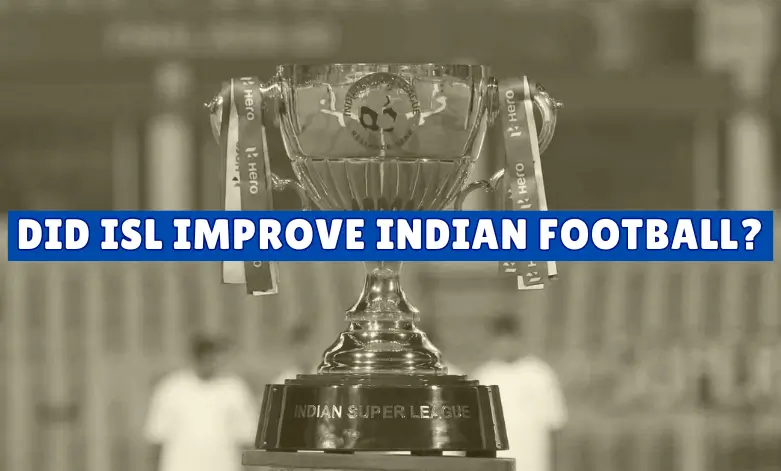Did ISL Improve Indian Football?

The Indian Super League (ISL) kicked off in 2014 with a promise to change Indian football. With all its glitz, glamour, and big-name signings, it definitely grabbed the nation’s attention. But has it really made a difference? Has the ISL helped Indian football grow, or is it just a flashy distraction?
Recent events in Indian football have highlighted the sport’s challenges. Former Indian national team coach Igor Stimac resigned, criticizing the “imprisoned” state of Indian football. This, along with India’s poor performances in recent matches despite the talent of players like Sunil Chhetri, has sparked fresh debates about the sport’s future.
In this context, we need to look closely at the ISL’s impact on Indian football. Has the league given Indian players the platform they need to develop? Has it raised the overall standard of the game in the country? Or is it just about entertaining fans without addressing the grassroots issues?
Be with us as we dive into these questions and explore the complex relationship between the ISL and the broader landscape of Indian football.
The ISL Era: A Double-Edged Sword?
The ISL’s arrival was met with a wave of optimism. The league promised to elevate Indian football to new heights, attracting global attention and nurturing homegrown talent. Indeed, in many ways, it has delivered.
The Positive Impact
- Increased Popularity: Undeniably, the ISL has boosted football’s popularity in India. The league’s high-octane matches, coupled with star power and glamorous marketing, have drawn a vast audience.
- Infrastructure Development: Several ISL clubs have invested in state-of-the-art training facilities and stadiums, improving the overall football infrastructure in the country.
- Platform for Indian Players: The league has provided a platform for Indian players to showcase their abilities and compete at a higher level. Players like Sunil Chhetri, Gurpreet Singh Sandhu, and others have flourished in the ISL.
- Financial Growth: The league has attracted significant investments, leading to increased financial stability for clubs and better player salaries.
The Challenges and Criticisms
While the ISL has undoubtedly made strides, it has also faced criticism.
- Overreliance on Foreign Players: The league’s emphasis on marquee signings has often led to an overreliance on foreign players, limiting opportunities for Indian youngsters.
- Lack of Youth Development: Despite the presence of youth academies, the conversion rate of academy players to the first team remains low, raising questions about the effectiveness of youth development programs.
- Inconsistency in Performance: While the ISL has produced some thrilling matches, the overall level of competition has been inconsistent, with some teams dominating the league.
- Questionable Governance: Issues related to ownership, player transfers, and match-fixing have occasionally marred the league’s reputation.
ISL: A Catalyst for Infrastructure and Fan Engagement?
One of the most visible impacts of the ISL has been on the development of football infrastructure in India. Several ISL clubs have invested heavily in building world-class stadiums, training facilities, and academies. These developments have not only benefited the ISL teams but have also had a positive ripple effect on the overall football ecosystem.
Moreover, the ISL has played a crucial role in igniting fan passion. The league’s vibrant matchday atmosphere, coupled with aggressive marketing, has created a dedicated fan following. The emergence of passionate fan clubs has added to the overall excitement and fervor surrounding Indian football.
However, it’s essential to note that the impact of the ISL on infrastructure and fan engagement has been uneven. While some cities have witnessed significant improvements, others have lagged behind. Additionally, sustaining fan interest beyond the glitz and glamour of the league remains a challenge.
ISL’s Impact on the Indian National Team

The performance of the Indian national team is a crucial barometer of the overall health of Indian football. The ISL has undoubtedly influenced the national team in several ways.
Positive Impact on the National Team
- Talent Pool: The ISL has expanded the pool of talented players available for national team selection. The league’s competitive environment has helped players improve their skills and fitness, making them more capable of representing the country.
- Exposure to International Standards: Playing alongside foreign stars has exposed Indian players to international standards, enhancing their ability to compete at the global level.
- Increased Media Attention: The success of the ISL has led to increased media coverage of Indian football, which has helped raise the profile of the national team.
Challenges and Areas for Improvement
Despite the positive contributions, the ISL’s impact on the national team has been mixed.
- Short-Term Focus: The ISL’s short season and intense competition can disrupt the national team’s preparation for international tournaments.
- Player Burnout: The demanding ISL schedule can lead to player burnout, affecting their performance for the national team.
- Lack of Consistency: The Indian national team’s performance has been inconsistent, highlighting the need for sustained development and improvement.
To maximize the benefits of the ISL for the national team, a closer collaboration between the league and the All India Football Federation (AIFF) is crucial. This includes aligning the ISL calendar with the national team’s schedule, implementing player rest periods, and focusing on long-term player development.
Challenges and the Road Ahead for Indian Football
Indian football, despite the strides made, faces numerous challenges that hinder its progress.
Key Challenges
- Grassroots Development: The lack of a robust grassroots structure is a major obstacle. Identifying and nurturing young talent from a tender age is crucial, but the system is still underdeveloped.
- Infrastructure: While improvements have been made, there’s a need for more world-class training facilities and stadiums across the country to support the growth of the sport.
- Administrative Issues: The governance of Indian football has faced its share of controversies, affecting the overall development of the sport.
- Competition with Other Sports: Cricket’s dominance in the Indian sports landscape poses a significant challenge in terms of media attention, sponsorship, and fan base.
The Road Ahead
To realize its full potential, Indian football requires a multi-faceted approach.
- Strengthening Grassroots: Investing heavily in grassroots development programs is essential to build a strong talent pipeline.
- Improving Infrastructure: Creating world-class training facilities and stadiums will attract top talent and improve the overall standard of the game.
- Good Governance: Ensuring transparent and efficient administration is crucial for the long-term growth of the sport.
- Developing a Football Culture: Fostering a football culture from a young age is vital to increase the sport’s popularity.
- Leveraging the ISL: Maximizing the potential of the ISL by addressing its shortcomings and aligning it with the national team’s goals is essential.
Indian football has the potential to become a global powerhouse. With concerted efforts from all stakeholders, including the government, football associations, clubs, and fans, the nation can overcome challenges and embark on a journey towards footballing glory.
Recommendations and the Future of Indian Football
To truly elevate Indian football to the global stage, several key recommendations can be implemented:
Specific Recommendations
- Comprehensive Grassroots Development:
- Establish football academies in schools and colleges.
- Organize regular youth tournaments and leagues.
- Provide adequate coaching and infrastructure at the grassroots level.
- Enhanced Player Development:
- Implement a clear player development pathway, from grassroots to the national team.
- Focus on specialized training for different positions.
- Provide opportunities for players to gain international experience through exposure tours and friendly matches.
- Improved League Structure:
- Consider a longer ISL season to allow for better player development.
- Introduce a promotion and relegation system to increase competitiveness.
- Strengthen the I-League to create a robust domestic football ecosystem.
- Stronger Governance:
- Ensure transparency and accountability within football administration.
- Invest in professionalizing the management of clubs and the federation.
- Implement effective anti-corruption measures.
- Increased Investment:
- Attract private investment in football infrastructure and development.
- Seek government support for the growth of the sport.
- Explore opportunities for international partnerships and collaborations.
Potential Scenarios for the Future
- India as a Footballing Powerhouse: With sustained investment, improved infrastructure, and a strong focus on youth development, India could emerge as a dominant force in Asian football and compete at the global level.
- A Strong Domestic League: The ISL could evolve into a highly competitive league attracting top international talent, rivaling some of the best leagues in the world.
- Increased Popularity: Football could become the most popular sport in India, surpassing cricket in terms of fan base and viewership.
- Global Football Destination: India could become a preferred destination for international football tournaments and matches, attracting global attention.
While challenges persist, the potential for Indian football is immense. By implementing these recommendations and fostering a passionate football culture, India can embark on a journey to become a global footballing powerhouse.
Challenges to Implementing Recommendations for Indian Football
While the recommendations outlined are crucial for the growth of Indian football, several challenges may hinder their implementation:
Financial Constraints
- Infrastructure Development: Building world-class stadiums and training facilities requires significant financial investments.
- Grassroots Development: Establishing and maintaining football academies across the country can be costly.
- Talent Development: Providing adequate coaching, facilities, and exposure to young players demands substantial financial resources.
Administrative Bottlenecks
- Bureaucracy: Implementing changes within the football administration can be slow due to bureaucratic hurdles.
- Corruption: The presence of corruption can hinder the effective utilization of funds allocated for football development.
- Lack of Expertise: There might be a shortage of qualified personnel to oversee the implementation of these recommendations.
Cultural Challenges
- Cricket Dominance: Overcoming the dominance of cricket in terms of media attention, sponsorship, and fan following will require sustained efforts.
- Parental Attitudes: Convincing parents to encourage their children to pursue football as a career can be challenging due to traditional career choices.
External Factors
- Economic Downturns: Economic recessions can impact the availability of funds for football development.
- Global Competition: The increasing competitiveness in global football requires continuous adaptation and improvement.
To overcome these challenges, a comprehensive approach involving government support, private investment, and strong leadership is essential. Additionally, creating awareness about the importance of football and its potential to contribute to the nation’s development can help garner public support.
Overcoming Challenges and Creating a Favorable Environment

Addressing the challenges facing Indian football requires a multi-pronged approach involving government, private sector, football associations, and the public.
Potential Solutions
- Public-Private Partnerships: Collaborate with private companies to invest in infrastructure, youth development, and marketing.
- Government Support: Increase government funding for football development, provide tax incentives for sports-related investments, and create favorable policies for the sport.
- Grassroots Development Focus: Prioritize grassroots programs by providing financial support, training coaches, and building infrastructure at the local level.
- Professionalization of Football Administration: Implement good governance practices, hire qualified professionals, and enhance transparency in decision-making.
- Fan Engagement: Organize fan engagement activities, create merchandise, and leverage social media to build a strong fan base.
- Infrastructure Development: Prioritize the construction of football-specific stadiums and training facilities in major cities.
- Talent Identification and Development: Establish a robust scouting system to identify young talent and provide them with world-class training.
- Media and Marketing: Increase media coverage of football, create attractive marketing campaigns, and collaborate with celebrities to popularize the sport.
Creating a Favorable Environment
To create a favorable environment for Indian football, it’s essential to:
- Build a Strong Football Culture: Encourage parents and schools to promote football as a viable career option.
- Develop Role Models: Create opportunities for Indian footballers to shine on the international stage, inspiring young players.
- Enhance Coaching Standards: Improve the quality of coaching education and certification programs.
- Leverage Technology: Utilize technology for player analysis, performance tracking, and fan engagement.
- International Collaborations: Partner with foreign football associations for knowledge sharing and player exchange programs.
By addressing these challenges and implementing the proposed solutions, India can create a strong foundation for the growth of football and achieve its potential as a footballing powerhouse.
Measuring Success and Learning from Others
To effectively evaluate the progress of Indian football, it’s essential to establish clear metrics and benchmarks. By tracking these indicators, we can measure the impact of our initiatives and identify areas for improvement.
Key Performance Indicators (KPIs)
- Participation Rates: Increase in youth football participation, number of registered players, and the number of football academies.
- Player Development: Number of Indian players in top-tier leagues, performance of the national team, and the number of players drafted by international clubs.
- Infrastructure: Increase in the number of football stadiums, training facilities, and artificial turfs.
- Fan Engagement: Attendance figures, TV viewership, social media engagement, and merchandise sales.
- Economic Impact: Revenue generated by the football industry, job creation, and government tax revenue.
Case Studies: Football Powerhouses
Analyzing the success stories of footballing nations can provide valuable insights. Countries like Brazil, Germany, and Spain have invested heavily in grassroots development, youth academies, and professional leagues.
- Brazil: Known for its exceptional talent pool, Brazil emphasizes grassroots development and early specialization. The country’s passionate fan base and strong football culture have also contributed to its success.
- Germany: Germany’s focus on youth development, excellent coaching infrastructure, and a well-organized league system have been instrumental in their rise.
- Spain: Spain’s emphasis on technical skills, possession-based football, and a strong youth academy system has yielded impressive results.
By studying these examples, India can identify best practices and adapt them to its specific context.
Conclusion: The Future of Indian Football
The Indian Super League has undeniably left an indelible mark on Indian football. Its arrival ushered in a new era of professionalism, fan engagement, and infrastructure development. However, the league’s full potential to propel Indian football to global heights remains untapped.
To truly realize this potential, a holistic approach is essential. Grassroots development, coupled with world-class infrastructure and a strong emphasis on player development, are the cornerstones of a successful football ecosystem. Good governance, increased investment, and a supportive football culture are equally vital.
India possesses a vast pool of talent and a passionate fan base. By learning from the successes of other footballing nations and implementing the recommended strategies, the country can embark on a journey to become a global football powerhouse. The road ahead is challenging, but with determination, perseverance, and a shared vision, Indian football can achieve its rightful place on the world stage.
Comparative Analysis
To gain valuable insights, it’s essential to compare India’s football journey with other Asian nations like Japan, South Korea, and Australia. These countries have achieved significant success in recent decades. By analyzing their strategies, infrastructure development, and youth development programs, India can identify areas for improvement and adaptation.
The Role of Women in Indian Football

Women’s football in India is steadily gaining momentum, but it still lags behind men’s football. Creating equal opportunities for female players, establishing women’s leagues, and promoting gender equality in football administration are crucial steps, just like we saw in Women’s IPL in cricket. By investing in women’s football, India can tap into a vast pool of talent and inspire a new generation of female athletes.
The future of Indian football is bright, but it requires sustained effort and a long-term perspective. By nurturing young talent, improving infrastructure, and creating a conducive environment for the sport to flourish, India can inspire generations of footballers and unite the nation through the beautiful game.





